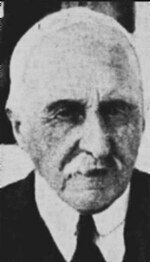Henry Merrick Lawson
Sir Henry Merrick Lawson | |
|---|---|
 Lawson in 1933 | |
| Born | 30 January 1859 Dublin, County Dublin, Ireland[1] |
| Died | 2 November 1933 (aged 74) |
| Allegiance | United Kingdom |
| Service/ | British Army |
| Years of service | 1877−1921 |
| Rank | Lieutenant-General |
| Unit | Royal Engineers |
| Commands held | 13th Infantry Brigade 2nd Division Guernsey and Alderney Northern Command |
| Battles/wars | Second Boer War World War I |
| Awards | Knight Commander of the Order of the Bath |
Lieutenant-General Sir Henry Merrick Lawson KCB (30 January 1859 – 2 November 1933) was a British Army General during World War I.
Military career[edit]
Educated at Cheltenham College and the Royal Military Academy Woolwich, Lawson was commissioned into the Royal Engineers in 1877.[2]
He took part in the Suakin Expedition and Nile Expedition in 1884 and served in the Egyptian Army during the Mahdist War in 1898.[2] He served in the Second Boer War between 1899 and 1902, and following the end of the war in June that year stayed on as Deputy-Adjutant and Quartermaster-General to the Forces in South Africa.[3] He became Director of Movements and Quarterings at the War Office in 1904.[2] He was appointed Commander of 13th Infantry Brigade in Dublin in 1906 and Major-General in charge of Administration for Aldershot Command in 1907.[2]

He became General Officer Commanding 2nd Division in 1910 and Lieutenant Governor of Guernsey and Alderney in 1914.[2] He went on to be Deputy Chief of the Imperial General Staff in November 1914,[4] General Officer Commanding-in-Chief for Northern Command in 1915 and then went into "Special Service" at the front in 1916.[2] He was critical that too many men were doing "soft jobs" in the War and thereby encouraged the formation of the Women's Auxiliary Army Corps.[5] Finally he was Inspector General of Communications for the Italian Expeditionary Force from 1917 to 1918; he retired in 1921.[2]
Political career[edit]
Lawson was twice a Parliamentary candidate for the Liberal Party. At the 1922 general election he stood in the constituency of Portsmouth South in a straight fight losing against sitting Conservative MP Herbert Cayzer. Soon after, Cayzer resigned through ill-health and when the new Tory MP Leslie Orme Wilson also resigned on his appointment as Governor of Bombay, Lawson was pressed back into service by the local Liberal Association. His opponent in the by-election, which took place on 13 August 1923, was none other than Herbert Cayzer, health clearly recovered.[6] Lawson's campaign, while not returning him to Parliament, reduced the Conservative majority from 5,867 to 2,121.[7]
Family[edit]
In 1912 he married Lady Wilma, daughter of the 5th Earl of Radnor, and widow of 2nd Earl of Lathom.[2]
References[edit]
- ^ "Man-Power in Egypt, Report". 17 May 1917.
- ^ a b c d e f g h "Great War Forum". Archived from the original on 28 September 2011. Retrieved 24 November 2009.
- ^ "No. 27496". The London Gazette. 18 November 1902. p. 7340.
- ^ Army Commands Archived 5 July 2015 at the Wayback Machine
- ^ Spartacus Archived 19 May 2009 at the Wayback Machine
- ^ The Times, 6 August 1923 p10
- ^ F W S Craig, British Parliamentary Election Results 1918-1949; Political Reference Publications, Glasgow, 1969 p219
External links[edit]
- 1859 births
- 1933 deaths
- British Army generals of World War I
- Knights Commander of the Order of the Bath
- Royal Engineers officers
- British Army personnel of the Mahdist War
- British Army personnel of the Second Boer War
- Liberal Party (UK) parliamentary candidates
- People educated at Cheltenham College
- British Army lieutenant generals
- Graduates of the Royal Military Academy, Woolwich
- Military personnel from County Dublin
